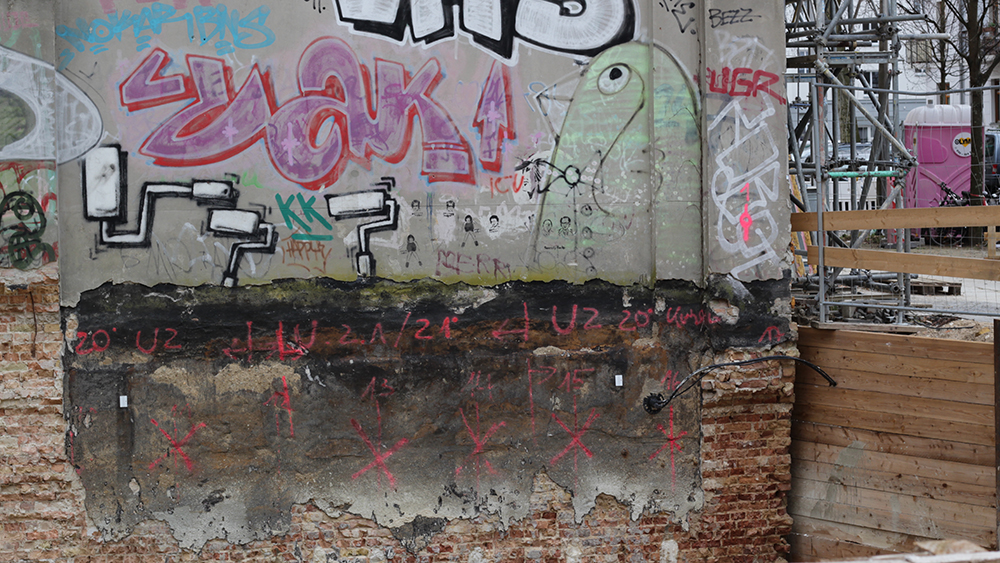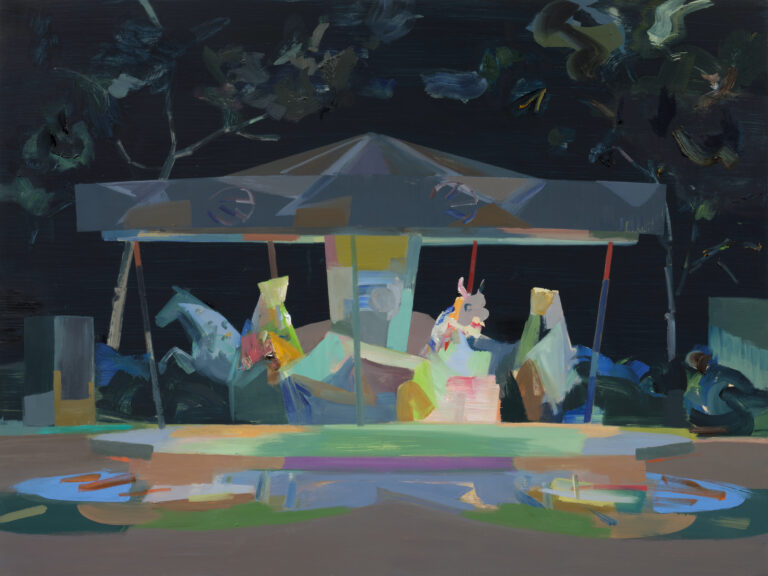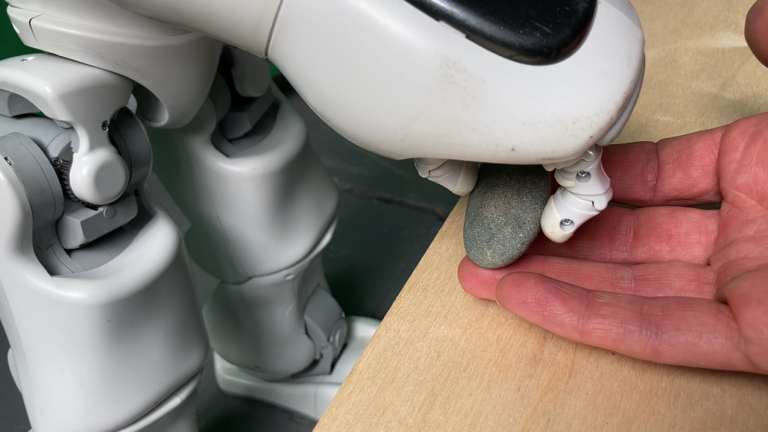
Baustellenbeschreibung (Building-site description)
Digital photograph, 2016
Courtesy of the writer
Ireland sits outside the main arteries of the international art industry, an industry with many major publishing arms. These major international publications produce art criticism that is accompanied by professional, alluring and illustrative photographs of the work(s) under consideration. The writing in these reviews become an accessory to the image and operates within a recognisable range of industry- standard art-critical tropes where the thrust of any criticism sits within the reflections that wind through the review itself, or more often come after a summary/journalistic description of the artwork in question that accepts the photographic image as dominant. The critical refections often require external cultural references – usually from elsewhere in the art world – for them to make sense and as such lack a certain internal coherence, but more so, writing of this kind ignores the critical and aesthetic potential in describing an artwork evocatively.[1] The act of describing an artwork well is an aesthetic and reflective/philosophic undertaking in and of itself. It is also a political act that draws attention to what the reviewer/critic values about art and how expanded a view the reviewer/critic has of what and where art can be.[2] Criticism of art need not sit wholly outside the aesthetics of the artwork being written about, as these publications that are part of the mainframe of the art industry seem to suggest.
Major international publications on art have, as such, increasingly become issuers of internal memos on developments within the business of art where writing is employed for dead-eyed promotion, or for peer-to-peer communication purposes. To gain an international reputation as an art critic, it is important to know how to inventively employ the tropes of these memos.[3] To take part in this international discussion it is important to be aware of this type of writing; it is also important to recognise how lifeless this type of industry-standard writing is.[4]
Why should these values and tropes of art criticism be rehearsed and embraced in Ireland? It makes developments in Irish art more industry-legible to an international market, but the use of this should also be pushed against.[5] Evocative art criticism is one place where a refusal of this kind can happen.
The photograph of an artwork that accompanies the review has not only become the enemy of evocative writing but also the need for evocative writing.[6] The photograph stifles the structures of subtlety that the writing, or the artwork in question, may have. The artwork, once represented in a photograph, struggles to live any differently in the mind of the reader as the photograph imposes itself onto any visuals that might be generated through descriptive writing. This is not to say that photographs of artworks should not be used in art criticism but how they are used ought to be reconsidered in a less autocratic manner. Currently the use value of the documentary photographic image has overtaken the overall aesthetic value of art criticism. A reconfiguration of the documentary photograph in art criticism will allow for more textual-imagining of artworks to play in the minds of those interested in reading about art. It may also affect how fashions in art play out and are valorised.
The photograph is largely unused in literary fiction because the world being generated is brought into being by the text and the imagination of the reader – so, what if we thought about evocative art criticism in terms of short-form fiction? The art review and short story are comparable in how they approach the art of placing objects into imaginary scenes.[7] In Flannery O’Connor’s 1958 essay/lecture “The Nature and Aim of Fiction” she talks about the importance of technique as something organic, something that grows out of the material … [8] The implications of this are manifold if you transfer it to the domain of art criticism in that it disintegrates many of the constructs that traditionally distance the writer/critic from the artwork under consideration. The artwork exists, but it can also be a multitudinous catalyst for other aesthetic acts, one of which can be called art criticism. O’Connor also states that good fiction writing appeals to the senses, and when appeals of this kind are used well they evoke, at least, a keen sense of place and action in the mind of the reader. Sensuous writing of this kind she claims is, however, often abused or overdone, which then leads O’Connor to the important idea of naturalism in descriptive writing:
In a strictly naturalistic work the detail is there because it is natural to life, not because it is natural to the work. In a work of art we can be extremely literal, without being in the least naturalistic. Art is selective, and its truthfulness is the truthfulness of the essential …[9]
If the word “work” in the above quotation is allowed to refer not only to the artwork but also to the work of describing it, there emerges further potential for art criticism in the perceptual gaps that appear when essentially detailing an art object or art scenario. These perceptual gaps are furtive absences that can be imagined into, through, and across by the active reader – and in this culmination of actions an artwork can also exist as an evoked, flickering (hyper)visual sensation in the mind of the reader, with an appropriately irreproduceable nature.
Descriptive writing happens along a spectrum between what is suggestive at one end and what is evocative at the other.[10] Both can coexist well but there are differences between these two modes of describing a thing. Suggestive writing is consonant with the sales pitch; it employs writerly contrivances that seek to dazzle the reader. It is a convincing form of writing but it is one where what is impressive in the description services the reader in the act of lending appreciation to the writer. Evocative writing, on the other hand, lies in darkness. Evocative writing, in the domain of the voiceless written word, gives a less assertive but more internally coherent sense of the nature of the writer and the relationship the writer has with the artwork he or she is evocatively describing. Evocative writing happens in an unlit room, the size of which is unimportant, but the writer in this instance believes the reader to be in the room also, though the writer has no way of knowing for sure, and it is in the scintillations of language that the writer feels they must throw out into this space that nature of his or her interaction with the artwork resides thus generating a new artwork, an infused visual that coruscates fairly in the mind of the reader. Evocative descriptions of artworks come from a use of language where what is poetic in the words is allowed to appear most fully. There is no poetry – but the world of language is full of what is potentially poetic. Criticism in this terrain exists as something bound to the tone of the evocation. Criticism is present and it is possible to forcefully imagine it in these instances. This type of criticism is less categorically bounded and happens long before anything is published; it sits within a series of critical acts that begins with the conception of the artwork and continues through suffusing the writing, editing, publishing and reading of the interpretation of the artwork.
Adrian Duncan is an artist and writer based in Ireland and Berlin. He is coeditor of Paper Visual Art Journal.ad
NOTES:
Thanks to Greg Baxter for his editorial help.
1. By internal coherence I mean the manner with which a sentence functions on a basic rational level. The focus here is the relationship between a sentence functioning and the vocabulary required on the part of the reader for it to do so. What are the assumptions by the writer when he or she writes a sentence, who does the writer believe their audience to be, and does the writer question their assumption in the course of their writing? How these critical judgements are negotiated reveals much about the politics of the writer. (Refer to note 4 below.)
2. This can also be applied to the publisher.
3. To do this takes considerable knowledge and skill on the part of the writer. Success of this kind is convincing, but it is success with a very specific kind of ambition for art criticism.
4. Some of these ideas I attended to in a short essay written in 2012 titled ‘Compassion in Art Criticism’, Paper Visual Art Journal, Limerick Edition. The text was an extension of my 2011 essay titled ‘A Proposal for Activation in Visual Art Writing’, Paper Visual Art Journal, Dublin Edition.
5. I think this issue is not just applicable to Ireland but also to other ‘outlying’ countries.
6. In Peter Rice’s An Engineer Imagines (1993), there is a chapter on the effect of photography on contemporary architecture and ‘its tyranny’ on the interpretation of a building’s structure. He believed architectural photography of the time flattened the importance of the building’s structure, and this he felt, removed other important kinds of access to the nature of a building. I think his thoughts have resonance here.
7. Gabriel Garcia Marquez’s ‘One of These Days’ is a very short story that I believe would teach students who study art criticism more about the potential of description than almost any art review I know.
8. Flannery O’Connor, ‘The Nature and Aim of Fiction’, in Mystery and Manners (New York: Farrar, Straus and Giroux, 2000), 67
9. Ibid., 70.
10. Current art criticism styles sit more towards the suggestive end of the spectrum. This is perhaps because a lot of work has to be done in a very short space of time, so short-hand description is necessary. I would imagine that there is some skill required in doing this well. I am aware that this distinction is perhaps a little extreme, but I think it is a worthwhile intrusion.



